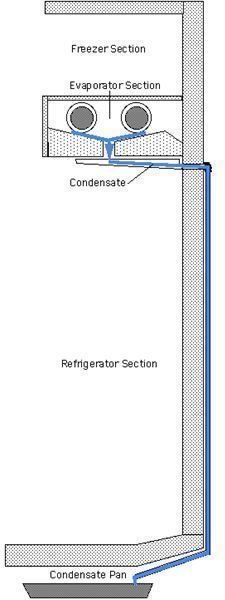What is Defrost System in Household Refrigerators?
The defrost system is found in all the refrigeration systems, household as well as the industrial systems. The refrigeration systems are used to develop temperature below the freezing point temperature of water. When the refrigeration systems works continuously for long periods of time a layer of ice or frost is built around the evaporator coil or the freezer that does not allows the cooling effect from the evaporator to pass into the freezer thus acting as the insulator. This leads to loss of the precious cooling effect and reduction of coefficient of performance of the refrigerator and ultimately excessive increase in the electricity bills. Thus the householder gets less freezing effect and has to pay more bills.
The process of removing the ice or frost from the evaporator or freezer is called as defrosting. The automatic controls employed in the present day refrigerators to prevent the formation of frost on the evaporators are called as the defrost systems.
Various Methods of Defrosting
In household refrigerators various methods of defrosting are employed, let us see some of these methods:
- Manual Defrosting
This is the oldest method of defrosting used in the earliest refrigerators that had no automatic defrost systems. When the householder sees the layer of ice on the evaporator coil of the freezer, they simply shut down the refrigerator and keep its doors open. Since the compressor has stopped there is no more formation of the cooling effect and the cabinet of refrigerator starts getting heated. The ice on the evaporator coil starts melting and gets completely removed after certain period of time thus completing the process of defrosting.
- Defrosting by Thermostat
The modern day refrigerators are fitted with thermostat that enables the user to set certain temperature in the freezer compartment as per their requirement. Besides this, there is a small plastic tray below the freezer compartment where the excess water from freezer is collected. When the temperature set by the user is attained the thermostat stops supply of power to the compressor and there is halt in production of the cooling effect. This occurs several times throughout the day. During this period, the ice collected on the evaporator coil of the freezer starts melting and the water, called condensate, is collected in the tray. This tray has a small outlet at its bottom back side in its middle part.
Small tubing is connected to this outlet and this tube comes outside from the backside of the refrigerator. In the bottom of the backside of refrigerator there is a compressor above which a small plastic condensate pan is kept. The tubing extends till this pan and the defrost water from the freezer is delivered here. Due to heat liberated by the compressor, the water in the pan tends to get evaporated. But sometimes the amount of defrost water is too high and the pan may overflow. In such cases the water has to be removed at regular intervals. This type of automatic defrost system is used in the single door refrigerators.
See the image below (source: https://www.the-appliance-clinic.com/images/condensate.gif)
- Defrosting by Heater
This automatic defrost system is employed in refrigerators with more than one door. In these refrigerators the freezer section is separated from the cooling cabinets. There is ducting in the PUF of the refrigerator that allows the flow of maximum cooling effect to the freezer and least to the cabinet meant for keeping the things cool. Apart from the thermostat, there is also a heater fitted to the evaporator coil of these refrigerators. At certain regular intervals, there is stoppage of supply of electricity to the compressor and at the same time the supply to the heater is started. This occurs for very short period of time, like few minutes and during this period all the frost accumulated on the evaporator gets removed. The condensate is collected via small tubing from the back of the refrigerator into a small plastic condensate at the bottom of the refrigerator, very much like in the previous case.
